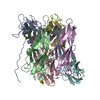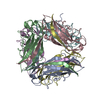+ Open data
Open data
- Basic information
Basic information
| Entry | Database: PDB / ID: 8psv | |||||||||||||||
|---|---|---|---|---|---|---|---|---|---|---|---|---|---|---|---|---|
| Title | 2.7 A cryo-EM structure of in vitro assembled type 1 pilus rod | |||||||||||||||
 Components Components | Type-1 fimbrial protein, A chain | |||||||||||||||
 Keywords Keywords |  STRUCTURAL PROTEIN / FimA / STRUCTURAL PROTEIN / FimA /  pilus / pilus /  monomer / subunit / pili / main structural subunit / monomer / subunit / pili / main structural subunit /  high resolution / high resolution /  cryo-EM / helical processing / cryo-EM / helical processing /  RELION / Chaperone-usher pilus RELION / Chaperone-usher pilus | |||||||||||||||
| Function / homology | cell adhesion involved in single-species biofilm formation / Fimbrial-type adhesion domain / Fimbrial protein / Fimbrial-type adhesion domain superfamily / Adhesion domain superfamily /  pilus / pilus /  cell adhesion / identical protein binding / Type-1 fimbrial protein, A chain cell adhesion / identical protein binding / Type-1 fimbrial protein, A chain Function and homology information Function and homology information | |||||||||||||||
| Biological species |   Escherichia coli (E. coli) Escherichia coli (E. coli) | |||||||||||||||
| Method |  ELECTRON MICROSCOPY / helical reconstruction / ELECTRON MICROSCOPY / helical reconstruction /  cryo EM / Resolution: 2.7 Å cryo EM / Resolution: 2.7 Å | |||||||||||||||
 Authors Authors | Hospenthal, M. / Zyla, D. / Glockshuber, R. / Waksman, G. | |||||||||||||||
| Funding support |  Switzerland, Switzerland,  United Kingdom, 4items United Kingdom, 4items
| |||||||||||||||
 Citation Citation |  Journal: Nat Commun / Year: 2024 Journal: Nat Commun / Year: 2024Title: The assembly platform FimD is required to obtain the most stable quaternary structure of type 1 pili. Authors: Dawid S Zyla / Thomas Wiegand / Paul Bachmann / Rafal Zdanowicz / Christoph Giese / Beat H Meier / Gabriel Waksman / Manuela K Hospenthal / Rudi Glockshuber /     Abstract: Type 1 pili are important virulence factors of uropathogenic Escherichia coli that mediate bacterial attachment to epithelial cells in the urinary tract. The pilus rod is comprised of thousands of ...Type 1 pili are important virulence factors of uropathogenic Escherichia coli that mediate bacterial attachment to epithelial cells in the urinary tract. The pilus rod is comprised of thousands of copies of the main structural subunit FimA and is assembled in vivo by the assembly platform FimD. Although type 1 pilus rods can self-assemble from FimA in vitro, this reaction is slower and produces structures with lower kinetic stability against denaturants compared to in vivo-assembled rods. Our study reveals that FimD-catalysed in vitro-assembled type 1 pilus rods attain a similar stability as pilus rods assembled in vivo. Employing structural, biophysical and biochemical analyses, we show that in vitro assembly reactions lacking FimD produce pilus rods with structural defects, reducing their stability against dissociation. Overall, our results indicate that FimD is not only required for the catalysis of pilus assembly, but also to control the assembly of the most stable quaternary structure. | |||||||||||||||
| History |
|
- Structure visualization
Structure visualization
| Structure viewer | Molecule:  Molmil Molmil Jmol/JSmol Jmol/JSmol |
|---|
- Downloads & links
Downloads & links
- Download
Download
| PDBx/mmCIF format |  8psv.cif.gz 8psv.cif.gz | 207.1 KB | Display |  PDBx/mmCIF format PDBx/mmCIF format |
|---|---|---|---|---|
| PDB format |  pdb8psv.ent.gz pdb8psv.ent.gz | 133.2 KB | Display |  PDB format PDB format |
| PDBx/mmJSON format |  8psv.json.gz 8psv.json.gz | Tree view |  PDBx/mmJSON format PDBx/mmJSON format | |
| Others |  Other downloads Other downloads |
-Validation report
| Arichive directory |  https://data.pdbj.org/pub/pdb/validation_reports/ps/8psv https://data.pdbj.org/pub/pdb/validation_reports/ps/8psv ftp://data.pdbj.org/pub/pdb/validation_reports/ps/8psv ftp://data.pdbj.org/pub/pdb/validation_reports/ps/8psv | HTTPS FTP |
|---|
-Related structure data
| Related structure data |  17863MC  6y7sC  8ptuC M: map data used to model this data C: citing same article ( |
|---|---|
| Similar structure data | Similarity search - Function & homology  F&H Search F&H Search |
- Links
Links
- Assembly
Assembly
| Deposited unit | 
|
|---|---|
| 1 |
|
- Components
Components
| #1: Protein | Mass: 18121.074 Da / Num. of mol.: 6 Source method: isolated from a genetically manipulated source Source: (gene. exp.)   Escherichia coli (E. coli) / Gene: fimA, pilA, b4314, JW4277 / Production host: Escherichia coli (E. coli) / Gene: fimA, pilA, b4314, JW4277 / Production host:   Escherichia coli BL21(DE3) (bacteria) / References: UniProt: P04128 Escherichia coli BL21(DE3) (bacteria) / References: UniProt: P04128 |
|---|
-Experimental details
-Experiment
| Experiment | Method:  ELECTRON MICROSCOPY ELECTRON MICROSCOPY |
|---|---|
| EM experiment | Aggregation state: FILAMENT / 3D reconstruction method: helical reconstruction |
- Sample preparation
Sample preparation
| Component | Name: Type 1 pilus rod / Type: COMPLEX Details: Type 1 pili assembled in vitro from recombinantly expressed as inclusion bodies and refolded FimA. Entity ID: all / Source: RECOMBINANT |
|---|---|
| Molecular weight | Value: 20.3 kDa/nm / Experimental value: YES |
| Source (natural) | Organism:   Escherichia coli (E. coli) Escherichia coli (E. coli) |
| Source (recombinant) | Organism:   Escherichia coli str. K-12 substr. W3110 (bacteria) Escherichia coli str. K-12 substr. W3110 (bacteria) |
| Buffer solution | pH: 7 / Details: in ddH2O. |
| Specimen | Conc.: 1.58 mg/ml / Embedding applied: NO / Shadowing applied: NO / Staining applied : NO / Vitrification applied : NO / Vitrification applied : YES : YES |
Vitrification | Instrument: FEI VITROBOT MARK IV / Cryogen name: ETHANE / Humidity: 70 % / Chamber temperature: 277 K Details: 3 ul sample, 30 s wait time, 0.5 s drain time, 6 s blotting |
- Electron microscopy imaging
Electron microscopy imaging
| Experimental equipment |  Model: Titan Krios / Image courtesy: FEI Company |
|---|---|
| Microscopy | Model: FEI TITAN KRIOS |
| Electron gun | Electron source : :  FIELD EMISSION GUN / Accelerating voltage: 300 kV / Illumination mode: FLOOD BEAM FIELD EMISSION GUN / Accelerating voltage: 300 kV / Illumination mode: FLOOD BEAM |
| Electron lens | Mode: BRIGHT FIELD Bright-field microscopy / Nominal magnification: 94340 X / Nominal defocus max: 3500 nm / Nominal defocus min: 1500 nm / Cs Bright-field microscopy / Nominal magnification: 94340 X / Nominal defocus max: 3500 nm / Nominal defocus min: 1500 nm / Cs : 2.7 mm / C2 aperture diameter: 70 µm / Alignment procedure: COMA FREE : 2.7 mm / C2 aperture diameter: 70 µm / Alignment procedure: COMA FREE |
| Specimen holder | Cryogen: NITROGEN / Specimen holder model: FEI TITAN KRIOS AUTOGRID HOLDER |
| Image recording | Average exposure time: 14 sec. / Electron dose: 97.54 e/Å2 / Detector mode: SUPER-RESOLUTION / Film or detector model: GATAN K2 SUMMIT (4k x 4k) / Num. of grids imaged: 1 |
| Image scans | Width: 8000 / Height: 8000 / Movie frames/image: 56 |
- Processing
Processing
| EM software |
| ||||||||||||||||||||||||||||||||||||
|---|---|---|---|---|---|---|---|---|---|---|---|---|---|---|---|---|---|---|---|---|---|---|---|---|---|---|---|---|---|---|---|---|---|---|---|---|---|
CTF correction | Type: PHASE FLIPPING AND AMPLITUDE CORRECTION | ||||||||||||||||||||||||||||||||||||
| Helical symmerty | Angular rotation/subunit: 115 ° / Axial rise/subunit: 7.76 Å / Axial symmetry: C1 | ||||||||||||||||||||||||||||||||||||
| Particle selection | Num. of particles selected: 516000 Details: Autopicking based on the 2D classes from manually chosen filaments | ||||||||||||||||||||||||||||||||||||
3D reconstruction | Resolution: 2.7 Å / Resolution method: FSC 0.143 CUT-OFF / Num. of particles: 11000 / Symmetry type: HELICAL | ||||||||||||||||||||||||||||||||||||
| Atomic model building | B value: 45.07 / Protocol: RIGID BODY FIT / Space: REAL / Target criteria: Correlation coefficient | ||||||||||||||||||||||||||||||||||||
| Atomic model building | PDB-ID: 5OH0 Pdb chain-ID: D / Accession code: 5OH0 / Source name: PDB / Type: experimental model | ||||||||||||||||||||||||||||||||||||
| Refinement | Cross valid method: NONE Stereochemistry target values: GeoStd + Monomer Library + CDL v1.2 | ||||||||||||||||||||||||||||||||||||
| Displacement parameters | Biso mean: 23.88 Å2 | ||||||||||||||||||||||||||||||||||||
| Refine LS restraints |
|
 Movie
Movie Controller
Controller





 PDBj
PDBj
